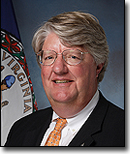Maintenance is consuming Virginia’s transportation budget, and members of a Commonwealth Transportation Board subcommittee agree that the state should change should the way it does business. But urban-rural differences could make it hard to reach agreement.
By James A. Bacon
The commonwealth of Virginia spends roughly $1.4 billion per year to maintain its road system but that massive sum has yet to pay off with smoother roads and sturdier bridges. According to a 2009 report, VDOT rated 31% of the state’s 98,000 miles of secondary road as deficient, a marked deterioration over the previous decade, and tagged 9% of the state’s 19,400 bridges and culverts the same. The Old Dominion doesn’t just lack sufficient funds to expand its transportation network, it barely has enough to keep up what it’s got.
Meeting for the first time in Richmond Wednesday, a subcommittee of the Commonwealth Transportation Board began reviewing how the state allocates its maintenance dollars. Its object: Determine if the money can be more effectively spent or more equitably distributed.
Although most of the session was devoted to reviewing background material, subcommittee members raised a number of issues that will shape the agenda in a follow-up meeting next month. Urban CBT members made clear their interest in revising VDOT formulas for allocating maintenance funds, which are based on the number of lane-miles of road in the state system. They raised the possibility of distributing funds on the basis of entirely different criteria, such as need, as measured by the condition of roads and bridges, or where investments can generate the highest economic return.
In a session where all members were actively engaged in the discussion, it was W. Sheppard Miller, a Norfolk businessman appointed to the board as an urban at-large member, who most forcefully made the case for an overhaul of the allocation formulas. If he could reinvent the maintenance allocation formula from scratch, Miller asked, why would he create one anything like the one Virginia has now? The current formula, which spreads money around the state irrespective of need or economic payoff, results in a system in which roads in some parts of the state are maintained in superb condition while roads in other areas are deteriorating.
“Does it make sense from a business perspective?” he asked. “I want to invest my scarce maintenance dollars where they give me the greatest return. If I’ve got four bedrooms in my house and one room needs to be painted, I’m not going to paint one wall in each room!
Miller argued that the lane-mile count is only one among several relevant metrics for prioritizing the allocation of dollars among state highway districts, where VDOT maintains the roads, and cities, towns and two counties (Arlington and Henrico), which maintain their own roads. “What’s the cost of having a poor secondary road system?” he asked. “Is the cost greater around Dulles than Farmville? If Rt. 15 through Prince Edward County isn’t in good shape, what’s the impact on the commonwealth, as opposed to a road through Dulles [airport] or to Hampton Roads? Some lane miles are more important [economically] than others. If I’m in a hurricane and my generator goes out, I’m not so concerned about the light in my attic. I’m very concerned about my refrigerator.”
Gary Garczynski, a Woodbridge developer and at-large urban member, backed Miller’s line of thinking. Allocation formulas must be equitable, he conceded, “but you’ve got to take into account the economic impact on the commonwealth. What’s going to deliver the greatest economic impact for the good of all of the citizens?”
The two rural at-large members, James Keen from Vansant in Southwestern Virginia and Allen Louderback from Luray in the Shenandoah Valley, did not contest the point but they did offer different perspectives. “We need to look at ways to enhance revenues,” Keen said. Louderback cited the rapid growth in the number of lane-miles in fast-growth counties, which resulted in them increasing their shares of the maintenance pot while leaving smaller shares for others. Developers routinely turn over secondary roads inside their subdivisions to the state to maintain. “We can’t keep adding things. Maybe we shouldnt.”



